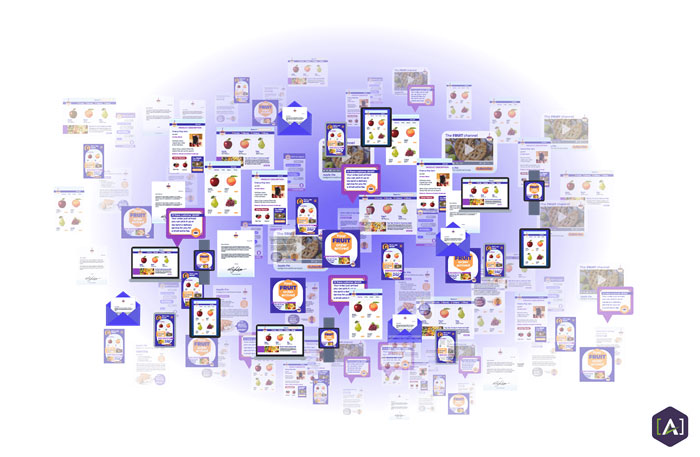Many of us discover that we have seemingly vast amounts of legacy content. This is content that is more-or-less sitting on the shelf, not in a structured format, and with limited ability to be searched or re-used. And yet, that content are some assets which are potentially highly useful, often with revenue potential.

The process of enriching legacy content is crucial due to our changing world. Content today must travel through, and be effective in, a wide array of application environments. It must be truly portable so that it can move between many tools and channels during the course of its full lifecycle. It must be fluid. Content must also be smart, given the roles being played by artificial intelligence enhanced interfaces, where software agents are playing an expanding role in helping people find, consume, and interact with content.
How did we inherent so much unstructured legacy content?
Although standards for content structure and content strategy have been around for years, we are often amazed at how much legacy content has no structure and no embedded tagging or metadata to enable intelligent interactions.
The following are common factors that helped increase the amount of unstructured legacy content companies may have:
- For decades, laptops have been bundled with user-friendly authoring tools like MS Word, which rewards the user for not using structure.
- Documents that were hastily created with an anticipated “short shelf life,” thus no effort was made to structure the asset. Changing market and customer dynamics often increase the need for that content.
- Mergers and acquisitions often pull in large amounts of documentation created by other teams. Such content probably now has outdated goals and priorities.
- Some content associated with a hasty product launch was created with the intent that “someday we’ll go back and recreate it with structure, to make it more useful.” Needless to say, revisiting that old content seldom occurs.
Regardless of where that legacy content came from, in far too many instances those assets were created with no capability for intelligently leveraging structure, e.g. having modular content. Massive amounts of content were created as unstructured “blobs” rather than as structural building blocks.
And, if we have content asset that are more than 10 years old, chances are that it was created with print and web display in mind, and no thought for other devices. Since customers can find our content via dozens of touchpoints and platforms, our content needs to be not only intelligent, but omnichannel.
Do you still need legacy content? Find out first.
Possibly the number one mistake that clients make when embarking on a project to upgrade content is neglecting basic analysis as to which content is worth saving, and which assets should be literally shelved. Organizations may have some lovely documents, with fabulous formatting and a great narrative thread that simply no longer support the organization’s objectives. Some content “downsizing” is often called for.

More importantly, are teams and stakeholders on the same page in terms of objectives for revitalized content? [A] has worked with many clients on an initial discovery engagement to analyze the vast amount of content organizations own. We find more often than not, teams vastly underestimate the sheer amount of assets they possess. Understanding the scope is the first step to making the decisions on what to depreciate and what to update.
Working with an organization’s longerterm strategy and success parameters, [A] provides clients with detailed recommendations, an actionable roadmap, and offers services to augment and support organizations of all sizes. If your organization needs support, reach out today.
Beyond strategy and tools
Since many organizations attempt to solve these common content hurdles solely in-house, they often go astray. Usually teams that are not fully informed gravitate to two solutions: a simple content strategy and some type of shiny new tool that will solve all problems.
Content strategy is essential, but it is only one of the practices that supports a strong content supply chain and ensures intelligent content flow. We elaborate on this later in the article.
To achieve success, teams need to activate their content strategy with the transformational power of
Content Engineering. This discipline is the practice of organizing the shape, structure, and application of content. Content engineering is broken down into seven primary disciplines: model, metadata, markup, schema, taxonomy, topology, and graph.
Usually some training and consulting are required to bring team members up to speed on these sub disciplines. To that end, [A] offers a wide array of engineeing practices and tools to support clients.
Reach out to learn more about how [A] can train and enhance your organization’s content engineering abilities. It’s time to enhance, connect, and strengthen your internal processes and ultimelty your customer experiences.
A connecting content structure: The Core Content Model (CCM)

Organizations of all sizes use multiple tools and systems to produce and distribute content. And we need these assets to be discoverable and useful to a broad ecosystem. To align all the requirements and insert the necessary structure across tools, [A] has proven the effectiveness of a single,
Core Content Model (CCM).
An CCM is a single, integrated model that defines how content assets will be structured and represented throughout their complete content lifecycle. The CCM focuses on the structure of content, literally its physical organization into components that can be enriched, reused, processed, and consumed.
By defining the structure of content assets, the CCM facilitates the creation, exchange, and utilization of semantic value. Here, semantics refers to the introduction of enriched meaning into the content in such a way that applications can find, interpret, and act on those details.
The CCM seeks to encompass the complete content asset lifecycle, from planning through delivery and use. It is a central goal of an CCM to facilitate the representation of content structures in all of the applications that will need to access, display, manage, and potentially modify the content. In this way, the CCM enables the flow of content between all of the applications that play a role in the content lifecycle.
Enriching content for dynamic delivery: the Core Semantic Model (CSM)
The solution to content discovery and dynamic delivery can be found in
semantics. In the context of content, semantics describes the meaningful relationships between a piece of content and external terms and structures. By creating and classifying these relationships, content structures are enriched in a way that allows content to easily be identified and used in many different contexts. This semantic enrichment is an essential ingredient in the convergence of content.
A
Core Semantic Model increases the value generated from content while also reducing the average spend per content asset by:
- Directly facilitating the efficient creation of multichannel, personalized customer experiences
- Allowing for the effective cross application deployment of content assets•
- Driving down cost by reducing the tendency to expensively and unnecessarily replicate content or semantic structures from department to department
- Making content easily findable, navigated, and accessed by both end users and content authors
- Providing the capability for a more streamlined content supply chain by increasing an organization’s capacity for content generation and delivery
- Providing a basic foundation to link an organization’s content into an integrated knowledge graph
Learn more about semantics and a CSM with this downloadable guide.
Don’t just update, make legacy content intelligent
We have touched on some of the complexity involved in making content intelligent, for instance, models, metadata, markup, schema, taxonomy, topology, and graphs. Obviously this requires dedicated teams with defined roles to maintain the flow in a content supply chain and ensure omnichannel delivery.
Rather than just convert legacy content into structured content, you also want to imbue it with intelligence that can make the following possible:
- Have tagging and metadata automatically applied to content modules to expand their capabilities
- Have content that is both human and machine readable to expand its reach
- Have content modules that can interact with APIs to automate manual tasks associated with content delivery
 The three pillars of content success
Content Engineering
The three pillars of content success
Content Engineering and
Content Strategy work in tandem with a third practice,
Content Operations. The Functions of Content Operations encompass breaking down silos between teams involved in the content process to solve underlying challenges. Content Ops connects with Content Strategy and Content Engineering to enhance the interaction between content supply chain processes, stakeholders, and tools.
Benefits of Content Operations include:
- Increasing content flow and effectiveness to create awareness around Content Intelligence
- Helping teams work together along the content supply chain
- Leveraging the power of the Content Orchestration Model, and how it can assist in managing the content lifecycle from start to finish
- Supporting for enterprise teams with the adoption of new standards and systems
Connect with [A] for professional services to enable content operations within your organization unique landscape.
What to remember when updating legacy content and processes
When upgrading legacy content, there is a lot of groundwork to get started. There are also a number of complex decisions to be made, thus we have recommended some process solutions. Don’t get distracted by the details. Keep your eye on the overarching goal:
- Enrich your content with enough intelligence to be easily found both externally and internally
- Ensure that your content has necessary ingredients to enable:
- Human consumption and machine consumption
- Responsiveness to customer intent and sentiment
- Content modules should be tagged for intelligent and automatic assembly into revenue generating assets
In short, most of what has been written about legacy content focuses on Content Strategy. By adding a healthy practice of Content Engineering and Content Operations governed by a
Content Orchestration Model, you can assure a flexible, dynamic content supply chain that is totally future-proofed.
Contact Us for a Free Consultation.